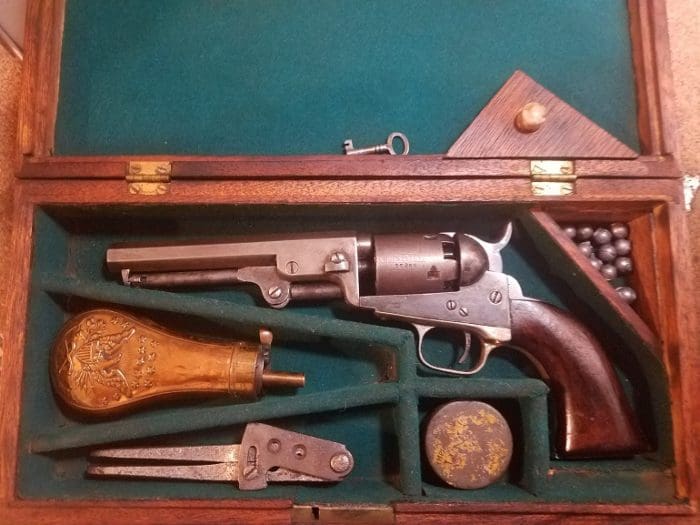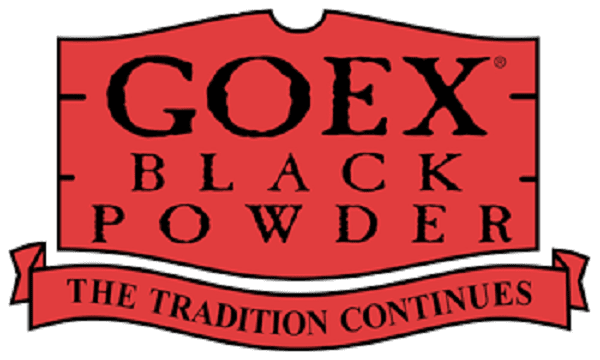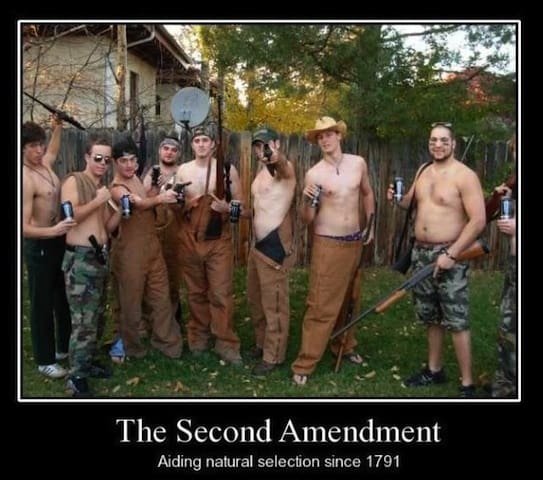It’s not the end of the world, but I can see it from here. Hodgdon Powder Inc. has announced that, effective immediately, it will cease all manufacturing at their Camp Minden, Louisiana plant.
For those of you few decent, God fearing Americans left among us, you know that plant as the facility currently manufacturing the GOEX and Olde Eynsford brands of black powder.
From the Hodgdon Press release:
Effective immediately, Hodgdon Powder Company, Inc. has made the decision to cease manufacturing operations at the company’s Camp Minden, Louisiana site while evaluating strategic options for the black powder business.
The business will wind down operations while an evaluation process on the future of the black powder business takes place. Strategic options for the GOEX and Olde Eynsford brands of black powder, along with the manufacturing capabilities, will include a potential sale of the business. All affected employees will be retained through December 31, 2021 to assist in an orderly closing of the site and receive severance commensurate with their years of service to the company.
The Hodgdon Powder Co., Inc has been honored to have been a part of the GOEX Powder legacy and sustains a fond appreciation for sporting customers who have enjoyed shooting GOEX powders.
This closure effectively ends commercial black powder manufacturing in the United States of America.

My first Blackbuck antelope was taken with a Traditions flintlock and GOEX powder. There’s just some kind of nostalgia in that boom, that smell, and that smoke.

And for some of us, some guns only get black powder. GOEX powder went in my original 1849 pocket when it was first made, and it still does today. GOEX has been a safe and reliable powder in America’s first successful concealed carry revolver since Colt made it.
Hodgon’s press release states it will be evaluating the future of the black powder business and may consider selling the brands.

Let’s hope someone jumps in on that business. There are many substitutes for black powder, but there’s really no substitute for black powder. My fellow Rendezvous enthusiasts and cowboy action shooters know what I mean.





Fkn sad.
The go to for my 1851 Navy Colt 44… Damn…
Oh wow, that sucks. I was really hoping to buy some GOEX black powder for my muzzleloader. Last time I tried to buy some, it was extremely hard to find–and quite pricey.
Sure, I can purchase “black powder substitute” for my muzzleloader. I would much rather purchase actual black powder.
Gotta start making my own then. Lets see, start with the basic formula … hmmmmm… sulfur, charcoal, now where did I put that potassium nitrate?
🙂
.40 cal Booger,
You know, you may have hit upon an interesting business opportunity. A simple “kit” approach, which makes it relatively easy for someone to make their own black powder, might sell surprisingly well. (The two keys to success are that GOEX will no longer be available and people who shoot muzzleloaders are a self-selected group who like to put more effort into their hobby.)
The kit would only require a simple measuring system and a mixer/tumbler. And then whoever makes/sells the kit would be smart to offer the raw ingredients for easy purchase. And, if the seller is really smart, they would offer the individual raw ingredients for sale in quantities which are already pre-measured in the proper ratio to simply combine and mix for black powder.
I have to seriously think about actually doing that.
Anyone have any idea if their are any regulatory requirements to selling charcoal, sulfur, and potassium nitrate? Are there any special shipping requirements when shipping those ingredients in separate containers in one box?
If it were that easy, the plant (run by professionals) wouldn’t have blown up.
Likely from a breach of safety protocol. I haven’t looked for the reports so it could be any number of reasons. Generally when things go bad it is a lack of safety and/or maintenance.
Big difference between making a pound at home and making tons of it daily.
Had to explain this to another guy who couldn’t figure out why making primers was so dangerous, they’re so tiny and hardly make a bang. He couldn’t picture making hundreds of pounds of compound at one time and that it makes a bigger pop if it goes off.
One of the most common sources of pure potassium nitrate is “stump remover”, you can get it at Lowes or Home Depot, among other places.
You can get Potassium Nitrate Powder 99.8% Pure – 5 Lbs – at Walmart for $23.10 > https://www.walmart.com/ip/Potassium-Nitrate-Powder-99-8-Pure-5-Lbs/919446004
You can also get Sulfur Powder – 99.5% Pure – 5 Pounds – at Walmart for $20.99 > https://www.walmart.com/ip/Sulfur-Powder-Brimstone-99-5-Pure-5-Pounds/236128200?athcpid=236128200&athpgid=AthenaItempage&athcgid=null&athznid=si&athieid=v0&athstid=CS004&athguid=y4Csrj5QK4OEs4xQttpI37AT-G_dmllDWzIY&athancid=null&athena=true
You can even order charcoal powder from various places. You mostly want powders. The formula is simple; Modern black powder recipes call for 75 percent potassium nitrate (AKA “saltpeter”), 15 percent charcoal, and 10 percent sulfur.
Some people say to use “saltpeter” but don’t be fooled by that. The term “saltpeter” is a collective term that refers to a number of different nitrogen containing compounds. Potassium nitrate is one of these and what is used to make black powder (AKA gun powder).
As I recall, you do have to “cook” the recipe. A little nerve wracking.
Charcoal and sulfur are probably not heavily regulated, potassium nitrate,d though has some potential as an explosive mixed with a combustible in the presence of lots of oxygen. The other issue would be getting the grain size right. Long ago I mixed some black powder that way and it acted kind of like commercial black powder, but it didn’t look at all like FFg black powder so there must be some more steps to manufacturing.
“…The other issue would be getting the grain size right.”
Science laboratory supply companies like ‘Fisher’ sell them.
Sizing screens come in various ‘mesh’ sizes (usually identified as a number “to the inch” or mm.
As I understand it, while damp, as a thick paste, BP is relatively safe to handle.
You put a ‘glop’ of it on the screen, and use a squeegee (or a credit card, in a pinch) to force it through the mesh. Take the risk of static electricity igniting it *seriously*, and ground everything metallic that can touch the powder. Floors must be bare, carpet is huge risk of static electricity…
I’ve made my own black powder, on and off, for years based upon the Goex formulation.
Every commercial company has their own recipe, but (almost) all commercial black powder recipes use the basics of 75 % potassium nitrate (AKA “saltpeter”), 15 % charcoal, and 10 % sulfur and adjust from there for fine tuning. The percentage is by weight not volume.
To be more exact, for example purposes, here’s a basic adjusted black powder gun formulation based upon a commercial (Goex) black powder:
74.6% potassium nitrate (AKA “saltpeter”)
13.8% charcoal
12% sulfur
then the company would adjust from there in processing and other ingredients.
Some formulations add up to about 7% water which improves its burning. People making their own and adding water usually end up with the wrong consistency of a paste, it never works out as well as it could or should.
If you use the water method its suppose to be the constituency of a lump of thick clay, if you have a paste you added too much water for the end product to burn as well as it should for a black power gun. Making it a paste lets too much water seep out, potassium nitrate is water soluble and when that paste water seeps away it takes some of the potassium nitrate with it which weakens the end product powder.
Then when its dry its broken up and ground down to a powder or granulated. The usual method is to press the clay mixture into pucks then let them dry, this really depends on the type of process you use but pucks are most common. Then break them up into the needed grain size (some method of grain size measurement will be needed, I use a screen method and it gets pretty close) and ball milling with red-gum and alcohol.
Commercial black powder has several different grain sizes ranging from FFFFg to Fg. Sizes “FFFg” and “FFg” are most common.
Contrary to belief of some, its necessary to start with finely ground ingredients (powdered ingredients – I gave links to some that work previously). The final product can be finally ground or granular depending on your use, for example, you want granular for black power guns and finally ground for fireworks type of uses.
Although you can make some forms of fireworks with regular black powder like above, fireworks grade “A” powders are mostly used in real fireworks in sizes 2FA, 4FA, Meal-D. You need a BATFE explosives license to produce “A” powders.
Garden fertilizer (potassium nitrate available at WalMart and other garden centers).
There was a kid on YouTube that made black powder from garden fertilizer. It was interesting as he altered the recipe to get his homemade M80 to go bang correctly.
I recall that the original source was batshit.
Now that’s crazy
Bat Guano… High levels of Nitrates AND Amonia… Great for building explosives AND growing pot… Back in the day we used chicken shit but Bats are evidently far superior at producing fertilizer, buy it in pellet form from a number of sources, make a liquid “tea” to feed your plants… Bat Shit… not THAT crazy any more…
Urine was also collected for the niter. I seem to recall reading an anecdote somewhere that in the earliest days of the practice, there was vigorous debate as to whether a wine drinker’s urine or a beer drinker’s urine was preferable as an “ingredient.”
Yes, I have read that several times over the years… bat guano was highly prized BITD and was shipped in from areas around the world.
Seem to recall that the skeet of aquatic birds which accumulated in nesting sites was also used.
Potassium nitrate, that shiny stuff sitting on top the mud in a swampish environment.
For the uninitiated, muzzleloaders–especially modern inline muzzleloaders–are a ton of fun to shoot.
Yes, they make a lot of smoke and you have to clean them as soon as you finish shooting. On the plus side, you can tailor your powder load (and hence muzzle velocity) an infinite number of ways right on the spot.
And guess what else is fantastic about muzzleloaders? They are wonderful for children! First of all, children love to see that large cloud of smoke that muzzleloaders create. More importantly you can reduce the powder load which reduces recoil for children. Less obvious: black powder burns relatively slowly and muzzleloader recoil is significantly less harsh than rifles shooting modern smokeless powder.
Example: a common/popular hunting load for a muzzleloader is 100 grains of black powder substitute and a 300 grain bullet which produces a muzzle velocity of something like 1,650 feet per second. That is far more muzzle velocity than is necessary to reliably/ethically take a white-tailed deer within 50 yards when you are launching a 300 grain, .50 caliber bullet. Instead (for children) you can load down to 70 grains of black powder and reduce recoil significantly while still retaining plenty of velocity to take a deer within 50 yards. And if you limit range to about 30 yards or so, you can probably even reduce the powder load down to 50 grains and have a truly tame level of recoil that even fairly young/small children can handle (with direct adult supervision of course).
Ahem. Black powder is an explosive and burns rapidly. Smokeless is a propellant and burns much more slowly. Try this test. Put down a five foot line of black and a five foot line of smokeless, Ignite each and you will see what i mean. The difference, and the reason you cannot use smokeless in a black powder firearm, is that smokeless generates more pressure as it burns and will blow an original black powder firearm to pieces as most were made with inferior steels (as compared to today).
The standard load for an 1861 Springfield is 60 to 75 grains under a 500 grain minie ball, and were effective out to about 300 yards against men. Being soft lead, minies tend to leave very large holes and were part of the reason for so many amputations during the Civil War; any bone impacted tended to shatter completely, even with muzzle velocities at 1100 fps or less. There really is no reason that modern hunters need to load up to 100 or 150 grains of powder to take game.
P.S.: The original .45-70 was a 405 grain bullet over 70 grains of powder, and aside from its rainbow trajectory, was effective to 1000 yards. Using a 500 grain bullet at the Sandy Hook tests of 1879, produced significantly superior ballistics, and could reach ranges of 3,350 yards (3,120 m), which were beyond the maximum range of the .45-70-405. While the effective range of the .45-70 on individual targets was limited to about 1,000 yards (915 m) with either load, the heavier bullet produced lethal injuries at 3,500 yards. In fact, at that long range a bullet penetrated a 4″ thick oak target and 8″ of sand. So don’t underestimate the power of your black powder loads!
Yea…
He lost me at 100 grains for a normal load and 70 for a child to shoot.
I shoot 70 grains under a round ball for deer, not a child load, still very much more than needed. 100 is near max.
But it is more of a push than a kick. Confusing terminology, neither explodes, both black and smokeless have burn rates, they burn to create gas, not explode.
An explosion is a chemical reaction that creates a rapid expansion of gases and pressures. The contained burn of the powder is an explosion.
Here is the legal definition of a firearm in my state: (4) “Firearm” means any weapon which will expel a projectile by the action of an explosive.
Your state is wrong.
The powder burns, rapid yes, but its a burn, it progresses from the ignition side to the opposing sides.
An explosion is when the entire mix sets off at the same time, just because its contained until pressures rise has no bearing on a rate of burn or explosion. However ATF does classify the license for black powder as an explosives license.
If the powder exploded it would rupture the barrel and you also would not have pressure curves, it would be peak and then down.
No Bob, you are wrong. Explosives do not “set off at the same time”.
Low Explosives, of which black powder is an example, have a detonation velocity between 2000 and 3000 feet per second. They also usually deflagrate instead of detonating.
High explosives have a detonation velocity over 5000 feet per second. Nitro based dynamite has a detonation velocity between 10,000 and 20,000 fps.
Here is the data sheet for black powder: https://www.google.com/url?sa=t&source=web&rct=j&url=https://www.epa.gov/sites/production/files/2015-05/documents/9530608.pdf&ved=2ahUKEwjrzqPlo6jzAhV-VzABHY7TBCMQFnoECDAQAQ&usg=AOvVaw2NrQocQi-a6Ft4Rv95t-xc
In addition to what Mark N. wrote, I’d add that (all else being equal) any given BP load will kick harder than an equivalent smokeless load, not because of burning characteristics but because of powder mass.
Recoil is momentum (mass x forward velocity of ejecta = mass x rearward velocity of firearm). The first part of the formula is often simplified to (mass x velocity of projectile) for smokeless because propellant mass is so low, but it counts.
If you use 70gr BP to push a 300GR bullet to the velocity of a similar-weight .44Mag projectile over 20gr of smokeless, your shoulder will feel the effect of the .44 with a ~350gr bullet at the same velocity. This is a simplification; some use 1.5x or another ratio for the powder gas velocity, so the effect is actually worse.
What they didn’t report in the story is that the plant and / or production line has blown up numerous times, closing down production of other products running on adjacent lines… I doubt they will return to production of Goex in the future, most likely at the insistence of their liability carrier.
Yep, the ghouls at Dewey, Cheatem & Howe are likely behind this.
Historically powder mills were known for this. It always was a tricky business to make black powder and as well transport and store.
Nothing beats the smoke of blackpowder. Fortunately there are many good sites that show how to make it and if you follow the warnings and the instructions you will do well. I tried a homemade mix in my rifle, it worked great. I just followed the directions, went slow and it was fun.
The materials were easy enough to source. Not sure how long until those are targeted.
Bought my second muzzle loader a couple of weeks ago, a beautiful Taylor and Taylor left handed “target” Hawken with a really nice double set trigger and adjustable sight. I was even thinking of dressing up and taking on the Identity of one of two 5x great uncles, who were early long hunters for some reenactments. Then I started looking for supplies. My other muzzle loader was one of the Hopkins and Allens from the 70s when black powder and no 11 caps were common. Everything has changed and not for the better, where cheap muzzle loaders designed to be used for special muzzle loader hunting seasons along with 509 primers and pressed Pyrodex pellets totally dominate the market. I did score a couple of pounds of FFg equivalent Pyrodex from Walley World and a thousand no 11 caps from Natchez Shooter’s Supply, for a trip to the range, but was hoping to find real FFg black powder somewhere. Now that sounds unlikely and even taking on the identity of my maternal great grandfather, a Union Sharpshooter, is unlikely without the availability of one of the important substances that built this nation.
You can buy Schuetzen or Swiss (imported) black powder brands from several suppliers in the U.S. when Goex and Old Eynsford brands are no longer available.
U S.A.
No lead smelting plants, no gunm powder plants.
We can depend on imports for what we need.
Until theBiden decides no more gunm related imports.
Prepare for the future, they” are.
Personally, I’ve always gone the Pyrodex route. Easier clean up, less fouling, and it still has that lovely sulfur smell. I’ve read Triple-7 is even cleaner, but never tried it. I’ve loaded .45 Colt to 40 grains with a 225 flat nose lead bullet; significantly more recoil than a “cowboy” load, but also more of a blast to shoot. I understand why the US Army specified a 35 grain load for its artillery pistols.
Too bad.
“This closure effectively ends commercial black powder manufacturing in the United States of America.”
More correctly said: “This closure effectively ends commercial black powder manufacturing in the United States of America for Black Powder guns.”
There are other U.S. companies that commercially manufacture black powder for supply to hobbyist, government, universities, and industry.
If you are going to make your own black powder for muzzle loaders (or for anything if you want the BP to work correctly), the mixing process is very important as is the formulation. Ball milling must be used if the black powder is going to work correctly. My first black powder attempts did not work well at all even though the formulation was correct, I did the mixing by hand. Someone suggested I use a ball mill, so I got one and my powders have worked well ever since.
You can get a ball mill here > https://unitednuclear.com/index.php?main_page=index&cPath=25_35 > (hint: for black powder you can use use lead grinding balls in the ball mill but the antimony/lead alloy balls work better – these grinding materials are spark free which is important.)
Man, this is really sad. Truly bad news.
Maybe they’ll retool and start making powders people actually use?
Primers aren’t my bottleneck anymore – it’s powder.
Truly sad to read about this. I no longer shoot black powder but I know lots of folks who do, and most of them find no pleasure in so-called “substitutes.” There is only real black powder, substitutes don’t count. I love my “cowboy guns” but these days they get only smokeless powder, but I loved knowing I could revert to black if I wanted. Appears that option will now be gone.
Pyrotechnic professionals and many hobbyists have been making their own BP for decades. The equipment and supplies are available online. There is a difference between pyrotechnic and “Sporting ” BP. The BP used for firearms is coated with graphite, pyro powder is not. Coating the powder and getting it uniform is an exacting process and regulating grain size ( Fs) is tricky for the beginner. The other factor is location. Ball Mills / tumblers can and will explode just like the commercial mills do and will. Making your own BP is not something you want to do in your home workshop. Goex will be missed.
Sad to see an Industry shut down, no matter what the cause. The history of Black Powder is interesting to read. It’s also full of amusing anecdotes and old wive’s tales. At one time, Nun Urine was collected and used in the Incorporation process, as it burned “Holier.” The reality was that urine helped wash the sulfer and nitrate in to the microscopic crevices of the charcoal. Since urine also contained nitrates, it did add to the explosive potential, but any urine worked.
I keep the ingredients on hand, but as I don’t currently own any BP firearms, I’ve not attempted to make any powder in a long time.
Flintlock vs Percussion Cap is the big question I have. If Caps become scarce, wouldn’t Flintlock ignition be the way to go? Styphnating Lead is not for the faint of heart. Fulminating mercury is even more hazardous.
So sad. Time fades away.
Oh, great now people are going to be collecting the urine from drunks.
That’s probably more worrying than people trying to corn powder at home.
There is a U=tube video of a young adult male making gun powder from his urine. I think there was a problem in the milling process because while he was thrilled with the resulting “explosion” in my view it was less than impressive for the quantity of “black powder” that was involved.
A real shame. This is probably the first time since 1776 that black powder hasnt been made here in the USA. Those interested in BP shooting will learn to make our own… until the feds make that illegal, too.
ระบบออโต้รวดเร็วจบในที่เดียว Pubgbet สล็อตออนไลน์ คาสิโน เกมไพ่ พนันกีฬาต่างๆ กีฬา ฟุตบอล บาส มวย มีโปรโมชั่นเด็ดทุกวัน เครดิตฟรี ทุกวัน โบนัสฝากครั้งแรก โบนัสฝากรายวัน ฝากถอนได้ไม่อั้น ไม่กำจัดต่อวัน
“HUAYDED789 หวยออนไลน์ 24 ชั่วโมง ระบบที่ทันสมัย แทงหวยง่าย โอนเงินไว หวยออนไลน์ที่นี่จ่ายสูง ส่วนลดเยอะ โปรโมชั่นพิเศษสำหรับสมาชิกใหม่ และสิทธิพิเศษมาก มาย แจกเครดิตฟรีอย่างต่อเนื่อง”
Comments are closed.